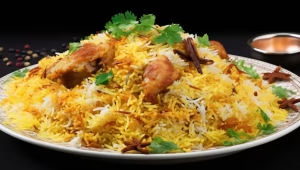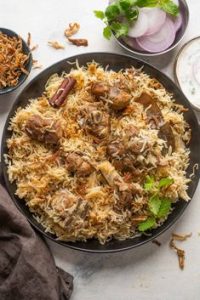Chicken pulao is one of the most beloved dishes in Pakistan, renowned for its subtle blend of flavors and its position as a staple meal for family gatherings, celebrations, and even casual dinners. The dish combines basmati rice, succulent chicken, and aromatic spices, creating a wholesome, flavorful one-pot meal that is deeply rooted in Pakistani culinary traditions.
Unlike biryani, which is known for its rich and fiery spices, chicken pulao offers a more delicate and nuanced flavor profile. This makes it appealing to a wide range of palates. With its relatively simple preparation and satisfying taste, chicken pulao is a dish that is cherished across Pakistan, from the bustling cities to rural villages.
This comprehensive guide will walk you through the history, variations, ingredients, and step-by-step instructions for preparing the perfect chicken pulao, a dish that is both flavorful and satisfying.
History and Origins of Chicken Pulao
The roots of chicken pulao can be traced back to ancient Persia, where similar rice dishes known as “pilaf” or “pilau” were enjoyed. As this dish traveled through Central Asia and into the Indian subcontinent, it adapted to the local ingredients and culinary techniques, giving rise to various versions of pulao in different regions.
In Pakistan, pulao has become a cherished dish, with each region offering its own take on the classic recipe. The traditional Pakistani version of chicken pulao is known for its balance of mild spices, fragrant rice, and tender chicken, making it a beloved comfort food.
Over the centuries, the dish has evolved into many forms, including mutton pulao, beef pulao, and vegetable pulao, but chicken pulao remains one of the most popular variations. Its simplicity, combined with the fact that it’s a one-pot meal, makes it a go-to dish for families across Pakistan.

Ingredients for Chicken Pulao
To create the perfect chicken pulao, it’s essential to gather the right ingredients. Here is a list of key components you’ll need to prepare this delicious dish:
1. Chicken
- 1 kg bone-in chicken pieces, preferably cut into medium-sized pieces.
Bone-in chicken is traditionally used for pulao because it enhances the overall flavor of the dish. You can also use boneless chicken if you prefer, but it may not deliver the same depth of flavor.
2. Basmati Rice
- 3 cups of basmati rice, soaked for 30 minutes.
Basmati rice is long-grain rice known for its aroma and non-sticky texture, which makes it ideal for pulao. Soaking the rice before cooking helps in making it fluffy and prevents it from becoming mushy.
3. Spices
Aromatic spices are the heart of chicken pulao. The key spices you’ll need are:
- 2-3 bay leaves
- 3-4 green cardamom pods
- 2-3 cloves
- 1-2 cinnamon sticks
- 1 tsp black peppercorns
- 1 black cardamom pod (optional)
- 1 tsp cumin seeds
- 1 tsp coriander powder
- 1 tsp garam masala powder
- 1 tsp salt (adjust to taste)
4. Onions
- 2 large onions, thinly sliced.
Caramelized onions add depth to the dish, providing both sweetness and a rich color to the pulao.
5. Ginger-Garlic Paste
- 2 tbsp ginger-garlic paste.
This paste is essential for marinating the chicken and adding flavor to the dish.
6. Green Chilies
- 3-4 green chilies, slit.
Adjust the number of chilies based on your spice preference.
7. Yogurt
- 1 cup plain yogurt.
Yogurt is used to tenderize the chicken and give the pulao a creamy consistency.
8. Tomatoes
- 2 medium tomatoes, chopped.
Although not always a part of traditional pulao, tomatoes can add a slight tanginess to the dish.
9. Cooking Oil/Ghee
- ½ cup cooking oil or ghee.
Ghee is often used for a more traditional and richer flavor, but cooking oil can be used as a substitute.
10. Fresh Coriander and Mint Leaves
- 2 tbsp fresh coriander leaves, chopped
- 2 tbsp fresh mint leaves, chopped
Fresh herbs are used for garnishing and to add a burst of freshness to the dish.
11. Water or Chicken Stock
- 5-6 cups of water or chicken stock.
Using chicken stock instead of plain water will enhance the overall flavor of the pulao.
Preparing Chicken Pulao: A Step-by-Step Guide
Now that we have gathered all the ingredients, let’s dive into the cooking process. The key to making the perfect chicken pulao is balancing the flavors and ensuring that the rice and chicken are cooked to perfection.
Step 1: Marinate the Chicken
Begin by marinating the chicken to infuse it with flavor. In a large bowl, combine the chicken pieces with the ginger-garlic paste, yogurt, salt, and half of the garam masala. Mix everything well, ensuring that the chicken is evenly coated with the marinade. Cover the bowl and refrigerate for at least 30 minutes, or up to 2 hours for deeper flavor.
Step 2: Prepare the Rice
While the chicken is marinating, wash the basmati rice thoroughly until the water runs clear. Soak the rice in cold water for about 30 minutes. This step helps in achieving fluffy and separate grains of rice once cooked.
Step 3: Fry the Onions
In a large pot or heavy-bottomed pan, heat the oil or ghee over medium heat. Add the sliced onions and fry them until they turn golden brown and caramelized. This step is crucial for developing the base flavor of the pulao. Once the onions are fried, remove about half of them from the pot and set them aside for garnishing.
Step 4: Sauté the Spices
To the remaining onions in the pot, add the whole spices: bay leaves, green and black cardamom pods, cloves, cinnamon sticks, black peppercorns, and cumin seeds. Fry the spices for a minute or two until they release their aroma.
Step 5: Cook the Chicken
Add the marinated chicken to the pot and cook on medium-high heat, stirring occasionally until the chicken starts to brown. This process helps seal in the flavors and allows the chicken to develop a nice color.
Next, add the chopped tomatoes, green chilies, and coriander powder. Cook for another 5-7 minutes until the tomatoes break down and blend with the chicken, creating a rich masala base.
Step 6: Add Water or Chicken Stock
Once the chicken is cooked and the masala has thickened, pour in the water or chicken stock. Bring the mixture to a boil and then reduce the heat to low. Let the chicken simmer for about 10-15 minutes, allowing the flavors to meld together.
Step 7: Add the Rice
Drain the soaked rice and gently add it to the pot with the chicken and stock. Make sure to spread the rice evenly over the chicken without stirring too much. At this point, you want to ensure the rice remains on top and doesn’t sink to the bottom.
Step 8: Cook the Pulao on Dum
Cover the pot with a tight-fitting lid to trap the steam inside, creating a “dum” effect. If you don’t have a tight lid, you can seal the pot with aluminum foil or place a heavy object on top of the lid. Reduce the heat to the lowest setting and let the pulao cook for about 15-20 minutes.
During this time, the rice will absorb all the flavors from the chicken and spices, while the steam will ensure the rice cooks evenly. Avoid opening the lid during the dum process, as this will release the steam and disrupt the cooking.
Step 9: Fluff the Pulao and Garnish
After the cooking time is up, turn off the heat and let the pulao rest for 5-10 minutes. This resting period allows the flavors to settle. Gently fluff the rice with a fork to mix the chicken and rice layers.
Garnish with the reserved fried onions, fresh coriander leaves, and mint leaves.
Serving Suggestions for Chicken Pulao
Chicken pulao is a versatile dish that pairs well with a variety of accompaniments. Here are a few traditional sides that elevate the pulao experience:
1. Raita
Raita is a cooling yogurt-based side dish that helps balance the flavors of pulao. You can make a simple cucumber or mint raita by mixing yogurt with grated cucumber or mint, along with a pinch of salt and cumin powder.
2. Salad
A fresh vegetable salad made with cucumbers, tomatoes, onions, and green chilies adds a refreshing crunch to the meal. Sprinkle with a dash of lemon juice and salt for added flavor.
3. Pickles and Chutneys
Spicy mango pickles or green chutneys are a great accompaniment to pulao, offering a tangy and spicy contrast to the mild flavors of the rice and chicken.
4. Shami Kebabs or Seekh Kebabs
For a more elaborate meal, you can serve chicken pulao with shami kebabs or seekh kebabs, adding a protein-packed side dish that complements the pulao’s flavors.
Tips for Making the Perfect Chicken Pulao
- Use High-Quality Basmati Rice: The quality of the rice plays a huge role in the texture and flavor of the pulao. Opt
-
- nd more aromatic dish. This variation is particularly popular in the northern regions of Pakistan.

